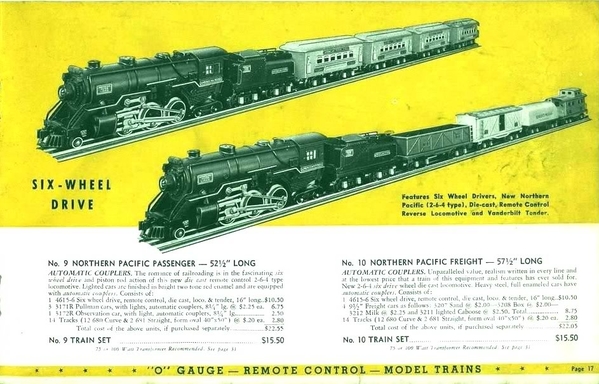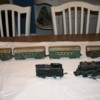hi,i have these two great little guys one is the 425 the other I would guess is a 426 ?,per the book the trailing truck on the 426 ? (on the right) looks correct,but seems to ride to high,,are they correct ? should both loco's have the same leading /trailing truck ? need some valve gear for the one on the right,thanks as always ,terry
Replies sorted oldest to newest
Same loco, one is from 36-37 and the later one is 38/39 ish. The 425 is later, it should have an E unit in the cab. Gregg, aka Northwoods Flyer will probably be along with more info, but that is generally it. The change in numbers would seem to match the move from Chicago to New Haven when AC Gilbert bought AF. Check out the catalogs loaded on the Eli Whitney AC Gilbert site, will be helpful as well.
Here is one catalog page and a picture of the sister engine with four big drive wheels that I have. You may also have one. I also think the white stripe was specific to a particular year.
Attachments
Well here I am, thanks to the third major snow storm in the last 2 weeks. This one is predicted to dump 8" - 11" inches of snow by the time it winds down tonight, and then the winds will be blowing. It seems like most of Central Wisconsin is shut down. My agency is closed today, so this makes it a perfect day to talk and play trains. ![]()
I am not sure that I will be of much help but I wanted to provide some additional information.
I use Greenberg's Guide to American Flyer Prewar O Gauge by Alan Schuweiler as a basis for most of my research. So let me quote a few passages. The guide categorizes Flyer's Steam Engines by boiler type.
The engines that Terry and Dennis are discussing are Type XVI. Let me quote from page 91:
Type XVI (1938 - 1940)
Catalog Nos. 423, 425, 4615-4, 4615-6
All 4 of these engines share the same boiler.
A third new type of die-cast locomotive was introduced in 1938, in both 2-4-4 and 2-6-4 wheel arrangements. They were cataloged as "Heavy Duty" engine in combinations No. 4615-4 and a Northern Pacific engine in combination NO. 4615-6 respectively. Both came with the older No, 3301 die-cast semi-Vanderbilt tender (Type VI), and both had "AMERICAN FLYER" decals below the cab window. The 4615-4 engine has large drive wheels, similar to the ones used on the contemporary Union Pacific, Atlantic and Hudson engines.

4615-4 borrowed from Google Images

4615-6 borrowed from Google Images (only vestiges of the white paint on the running board remain)
snip...
These engines returned in 1939 with American Flyer's new numbering scheme ( edit: because of the transition to the Gilbert era), 423 and 425, in combinations No. 424 and 427. (They do not follow the typical system of two digits above the engine-only numbers, since American Flyer used both 423 and 425 as engine only numbers.) The 423 used the old Type IV coal tender,

423 and tender borrowed from Google Images Binns Road site
while the 425 continued to use the die-cast semi-Vanderbilt oil tender, which was rubber stamped "AMERICAN FLYER"
photo of my engine
Combination No. 427 returned in two sets for 1940, the final year that American Flyer would catalog any of the older non-3/16-inch-scale locomotives.
So Terry,
Your engine on the right should be a 2-6-4. The trailing truck should be like the one on the left. The one that is on it is an American Flyer trailing truck but not used on this engine. It looks like it has been going through a restoration, so perhaps the truck was swapped out.
Dennis' catalog page is from 1938 with engines from the 4615-6 numbering era and I think that the white stripe on the running boards was only used that year.
I hope this helps with the confusion and doesn't add to it.
Northwoods Flyer
Greg
Greg J. Turinetti posted:Well here I am, thanks to the third major snow storm in the last 2 weeks. This one is predicted to dump 8" - 11" inches of snow by the time it winds down tonight, and then the winds will be blowing. It seems like most of Central Wisconsin is shut down. My agency is closed today, so this makes it a perfect day to talk and play trains.
I am not sure that I will be of much help but I wanted to provide some additional information.
I use Greenberg's Guide to American Flyer Prewar O Gauge by Alan Schuweiler as a basis for most of my research. So let me quote a few passages. The guide categorizes Flyer's Steam Engines by boiler type.
The engines that Terry and Dennis are discussing are Type XVI. Let me quote from page 91:
Type XVI (1938 - 1940)
Catalog Nos. 423, 425, 4615-4, 4615-6
All 4 of these engines share the same boiler.
A third new type of die-cast locomotive was introduced in 1938, in both 2-4-4 and 2-6-4 wheel arrangements. They were cataloged as "Heavy Duty" engine in combinations No. 4615-4 and a Northern Pacific engine in combination NO. 4615-6 respectively. Both came with the older No, 3301 die-cast semi-Vanderbilt tender (Type VI), and both had "AMERICAN FLYER" decals below the cab window. The 4615-4 engine has large drive wheels, similar to the ones used on the contemporary Union Pacific, Atlantic and Hudson engines.
4615-4 borrowed from Google Images
4615-6 borrowed from Google Images (only vestiges of the white paint on the running board remain)
snip...
These engines returned in 1939 with American Flyer's new numbering scheme ( edit: because of the transition to the Gilbert era), 423 and 425, in combinations No. 424 and 427. (They do not follow the typical system of two digits above the engine-only numbers, since American Flyer used both 423 and 425 as engine only numbers.) The 423 used the old Type IV coal tender,
423 and tender borrowed from Google Images Binns Road site
while the 425 continued to use the die-cast semi-Vanderbilt oil tender, which was rubber stamped "AMERICAN FLYER"
photo of my engine
Combination No. 427 returned in two sets for 1940, the final year that American Flyer would catalog any of the older non-3/16-inch-scale locomotives.
So Terry,
Your engine on the right should be a 2-6-4. The trailing truck should be like the one on the right. The one that is on it is an American Flyer trailing truck but not used on this engine. It looks like it has been going through a restoration, so perhaps the truck was swapped out.
Dennis' catalog page is from 1938 with engines from the 4615-6 numbering era and I think that the white stripe on the running boards was only used that year.
I hope this helps with the confusion and doesn't add to it.
Northwoods Flyer
Greg
greg ,thanks I have that book ,was just out of sight of the pix,,,i thought the trailing truck was wong,,will look for the proper replacement,,,terry
those are some good looking steamers
I kinda like the way the 2 wheel trailing truck looks! Sorta like what I did with my 2055 Lionel: put a 2 wheel delta trailing truck to replace the 4 wheel, making it into an honest Pacific.
Jim
Doing a little research on the 4615. it is quite interesting that the body was used for the two styles of wheel configuration. i believe it was Gilbert ditching off old inventory knowing the future. Both 4615 models did use the new style dual fixed axle rear truck and old style single floating wheels on the front. Like the new 425. Going to the 3/16" scale the old molds and shells were obsolete. It would be a profitable way to ditch old A.F. back stock and promote the new design while pushing the new model scale. No wonder there was so many issues with the rods and trucks.
@GILBERT GREG posted:Doing a little research on the 4615. it is quite interesting that the body was used for the two styles of wheel configuration. i believe it was Gilbert ditching off old inventory knowing the future. Both 4615 models did use the new style dual fixed axle rear truck and old style single floating wheels on the front. Like the new 425. Going to the 3/16" scale the old molds and shells were obsolete. It would be a profitable way to ditch old A.F. back stock and promote the new design while pushing the new model scale. No wonder there was so many issues with the rods and trucks.
Not sure I agree with you, as this casting first appeared in 1938, the year Gilbert took over American Flyer. As these castings were not "old AF back stock" and Flyer did not bring out 3/16th scale until 1940, 2 years after these castings were introduced, does not seem that your hypothesis is correct. Add to the fact that they sold the 425 with this casting with some of the low end 3/16th sheet metal cars in 1940 and I believe included the engine in at least one Erector set.
I would suspect that this was more of a new style engine to improve upon some of the older Chicago designs, until Gilbert could get the tooling done for his 3/16th items and bring them to market.
I was assuming that Gilbert did not have to me time to develop cast 4615 the year they bought the company i was amiss making it sound like it was old back room stock. it is strange the two totally different designs of drive wheels on the same shell. i would have to believe that the designs existed and A.F. just did not have the resources to push them out. Gilbert was thrifty. Thanks for the help.
@GILBERT GREG posted:it is strange the two totally different designs of drive wheels on the same shell.
Actually Gilbert did the same thing with the 43224/43226 and 432/435 of the years 1938 and 1939-40, these 4 engines used the same boiler casting and the 43224 and 432 featured 4-4-2 configurations and the 43226 and 435 featured 4-6-2 configurations
@GILBERT GREG posted:it is strange the two totally different designs of drive wheels on the same shell.
Just good use of resources. Not strange at all... the late prewar Lionel shell usage was as duplicative as Flyers...even more so.
BTW Terry, Flyer O gauge is as confusing as it gets! Your thread title is SOP for us! LOL









